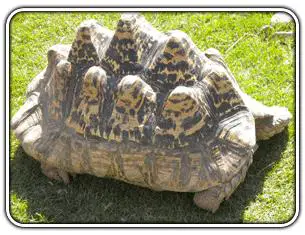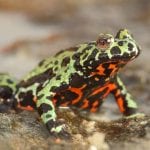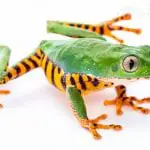One of the main problems related to keeping captive-hatched tortoises is the so-called pyramiding. Those tortoises with shells that suffer from this condition do not feel any hurt from their shells. Pyramiding is not a problem except when dietary deficiencies exist that can lead to specific health issues like malnutrition. However, a pyramiding shell does not look good. It is certified as a result of improper care.
Basically, tortoises have their shells growing horizontally as they grow. However, when they do not have a healthy diet, or their housing requirements were incomplete, the growth of their shells may switch from being horizontal to vertical. The normal development of the shells of tortoises under the ideal conditions will result in smooth shells. The opposite leads to ugly and bumpy shells.
What is Shell Pyramiding in Tortoises?
Pyramiding is a disease that affects both tortoises and turtles, which is more likely due to malnutrition and other related factors. The problem can be identified and diagnosed by the apparent pyramidic deformation of the scutes of the shells. Pyramiding is not a common issue in the turtles living in the forests as it can be due to incorrect husbandry and care for the animal. Pyramiding is not life-threatening except when the case is serious.
Pyramiding is a type of MBD or metabolic bone disease in which the scutes on top of the shells grow vertically and form a bumpy appearance. When pyramiding is serious, the top shell or carapace and the plastron or bottom shell may become extremely short. A healthy and normal tortoise must have hard shells that sound hollow if you tap it lightly. Juvenile tortoises might have softer plastrons. However, these shells will harden sooner with age. If not, supplementary outdoor time and exercise will be important to harden the soft shells or pyramiding tortoises.
Once you suspect that your pets are becoming pyramiding and bumpy, check quickly their enclosure and diets. This will help correct the culprit and stop the pyramiding problem in your tortoises.
What are the Causes of Pyramiding in Tortoises?
Based on who you talk to, you might get another answer. Therefore, you will find that it could be difficult to fully determine the exact causative factors associated with shell pyramiding in tortoises. Nobody knows the actual causes of the issue, but experts assume that the issue is the result of various factors, such as:
- Insufficient calcium
- Excessive protein
- Excessive phosphorus
- Excessive oxalates in food
- Overeating
- Insufficient vitamin D3 and calcium
- Less exposure to sunlight
- Lack of exercise
- Dehydration
- Poor humidity levels
- Grain-based diets
- Inadequate dietary fiber
Depending on the expert, the answer you will get may differ. Hence, you have to ensure that you follow the specific care limitations for the species of tortoises you may have. Some professionals out there claim that the locale and origin can be causes, including the genetics and the naturally domed scutes which look like pyramiding. This is a potential causative factor of pyramiding in some species of tortoises.
Malnutrition plays a big role in the development of pyramiding shells in tortoises. Its underlying cause of it is still a mystery, but too much protein in your pets’ diet appears to be a crucial factor. Other things like inadequate calcium absorption and calcium deficiency, including lack of exercise, are potential causes of shell pyramiding.
As the turtles become adults, their protein requirements will drastically reduce. The ideal food source for mature tortoises must be the combination of green vegetables. A well-balanced pellet diet is also highly recommended for them. Green vegetables will provide them with enough calcium and less calcium.
Symptoms of Shell Pyramiding in Tortoises
The symptoms of pyramiding are the individual scutes elevated higher than the normal dome form of their shells, forming another dome on top. Shell pyramiding can be minor or serious.
Normal vs. Pyramiding Shells
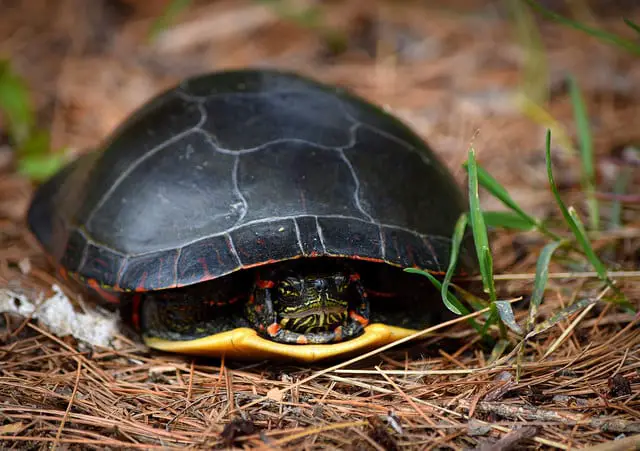
Tortoises have bottom and top shells that should harden as they grow old. These parts of their shells must be connected to one another, particularly on the sides of their bodies. These shells are so important that they protect the organs and most parts of their bodies.
The shells of tortoises consist of visible parts called scutes. These are crafted using keratin, which is the same with fingernails. The scutes are covering a sheet of epithelium that overlies the bony shells of tortoises. While the animals grow, their epithelium will form bigger scutes underneath the external scutes.
The external scute layer is the oldest. These scutes typically shed off in the water turtles as the animals grow and shed their skins. However, the bone under their scutes must not be left exposed. Land tortoises don’t shed their scutes, but the external layer is typically worn down in those species with burrowing abilities. The ribs and spine of the tortoises are connected to the bones of their carapaces.
As tortoises may differ from species to species in terms of appearance, some turtles and tortoises often have peaks to shells, but a lot of species don’t. pyramiding pertains to the abnormal formation of their shells that the scutes create a raised peak or pyramiding look.
Poor husbandry is a contributing factor to the development of these tortoises. Shell pyramiding can also take place with chronic malnutrition and inappropriate lighting. Wild tortoises wouldn’t acquire this issue unless trauma caused the shell to look pyramiding.
How to Stop and Treat Pyramiding
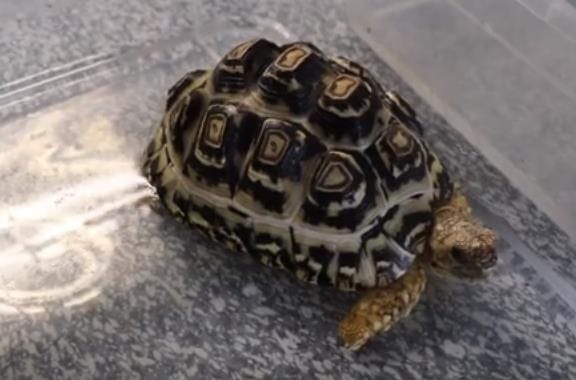
When you notice the early symptoms of pyramiding, then you may change the diet or housing of your pets to treat and stop the problem. If they have scutes that show pyramiding, you can’t do anything to reverse it. However, you can instead prevent future pyramiding from taking place.
By correcting their dietary limitations and housing requirements, you will succeed in stopping the abnormal growth of your pets’ scutes from making sure that new horizontal growth of the shells will take place.
It is so important to ensure that:
- Your pets are not overfed.
- Your pets receive proper humidity and enough water to drink.
- You give them time to exercise and leave themselves exposed to sunlight.
Hydration is so crucial. It comes with not only providing enough water but adequate humidity, too. Recent research revealed that tortoises kept in higher humidity level led to less pyramiding despite a diet that is high in protein.
The greatest plan to use is allowing your pets to receive more sunlight and ample space for grazing and roaming. Plant more edible flowers, grasses, and weeds inside their enclosure. Give them a wading pool of water where they can soak in and drink from. Also, keep this pool of water clean at all times. Give your tortoises some bones of cuttlefish as a good source of extra calcium that is necessary for the normal growth of their shells’ bones.
The greatest ground cover or substrate to use is cypress mulch or grass. Cypress and grass are both good at retaining humidity. The grass collects dew in the morning that will evaporate throughout the day. As your outdoor enclosure becomes heavily planted, you must water it more. Don’t hesitate to hose your pets down in this situation. Spray bottles are better to use for an indoor enclosure.
Also, to stop your pets from getting their shells pyramiding, be sure the tank is big and wide enough for all of them. The basic type of exercise needed for aquatic turtles will be swimming. This means providing the tortoises with a big tank is essential. Aside from that, you may also allow your pets to exercise by taking them out of the tank and allowing them to run. However, you must supervise them whenever you allow them to roam freely outside the enclosure. Leaving them unattended may result in unexpected situations like getting them attacked by your cat or dog.
Tortoise Pyramiding Prevention
Prevention will be the most effective way of treating shell pyramiding. You have to be sure that you have done proper research before buying a pair of tortoises. This way, you can prevent those possible issues that may happen due to poor diet and bad housing setup. You have to meet the requirements for diet and housing to ensure that your pets will grow healthy and happy. Proper diet and husbandry are keys to preventing a variety of health problems or diseases in tortoises.
Preventing shell pyramiding is the most vital thing. Hence, you may want to ensure that your pets receive adequate proteins and calcium in their diets, humidity, water, exercise, and sunlight exposure. If you have juvenile tortoises, be sure that their housing and dietary needs are provided. This will not only help in preventing them from getting their shells growing vertically but will let them have a longer and healthier life.
Conclusion
Pyramiding is not a simple issue to consider. You must resolve it as soon as you notice the problem with your pets. Hopefully, the tips given here will help you ensure the overall health of your pets. Also, they will give you peace of mind that your tortoises stay in good condition for the rest of their lives.

